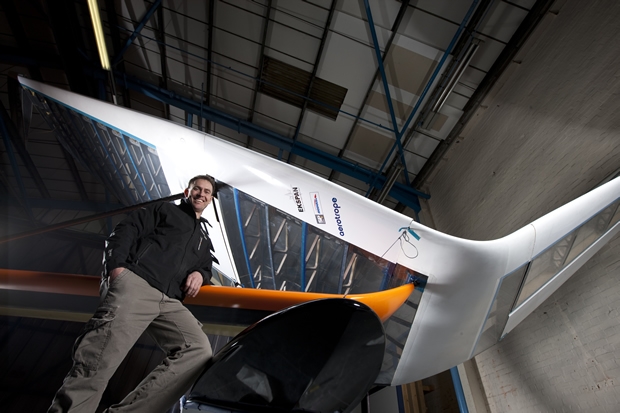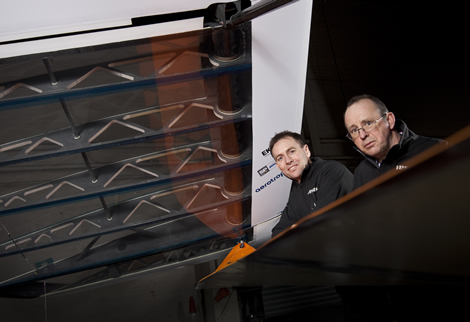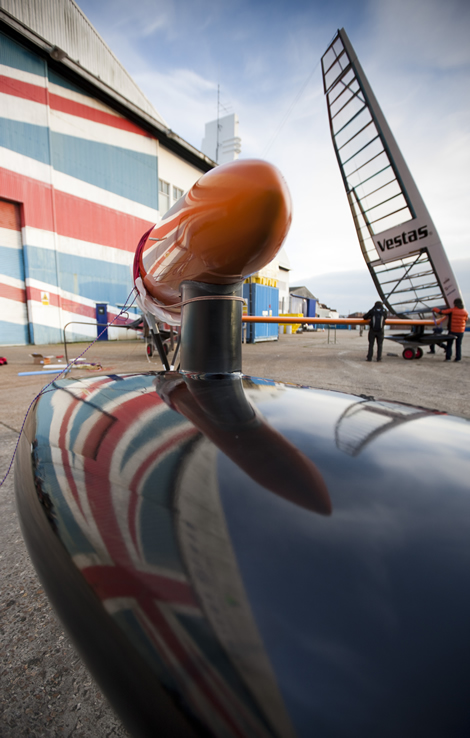
Kiteboard eater - part 2
This article follows part one
Compared to C-Class wings or those found on the AC boats, the new Vestas SailRocket wing is more like that of an aircraft in that it only has to operate on one tack with a limiter to prevent it backwinding. Due to the shrouds (it is held up and is raised and lowered via a strut attached to a track on the crossbeam – as it was on Mk1) the wing has had to be divided into two main sections – the top section can rotate through 360 degrees while the lower section rotates through around 90degrees.
“It is quite easy, you just put the pivot in the right place and have the right section,” says Barnsley of how they made it feather. “The reason we didn’t have it before was because we were greedy. We went for the ultimate in power at the expense of handle-ability. If you back off a bit, you can make it practical. And other aspects of the wing changed and in the end it is more efficient anyway. It was just a crazy decision on the first boat.”
The very bottom section of the wing is fixed in place and Barnsley says this will be a useful reference point for the pilot – although we suspect at the front of the boat Larsen will now need a wing mirror...
As mentioned, in the cockpit there are two controls for the main sheet and beam articulation. Larsen doesn’t expect there to be much load in either and so there is a 2:1 on the sheet and at present a 3:1 on the articulation for the beam. He is pleased with the Spinlock clutch arrangement as it means he is no longer having to flick ropes off and also has arranged it so that he isn’t “sitting in a pool of spaghetti like I was with the last boat. I want the line to come up and disappear and just hold and when it is ease time you just press that and all the clutches release.”
Another area of development is in the ride height of the leeward float. Larsen says that on Mk1, it started to fly at 50 knots, as it was designed to, but it remains to be seen what happens when it goes faster. “If that float starts flying at 50 knots then at 60 knots it could be 6ft in the air! We found on the last boat that that float would only come out at 50 knots, and the boat would only do 53 knots, so near its maximum speed at 50 knots it would hover beautifully. We’ve steered away from active controls on as many parts of this boat as we can, but if the boat did 60 knots, you’d need an active control for that. That wouldn’t be critical, because as it gets higher you start to get download on the beam and it would get to a point where it would stabilise.” Even so, the first capsize to windward would be novel. Perhaps they could arrange for the shorter section of wing to self-stabilise?
Larsen says the potentially significant issues they may face starting SailRocket 2 are in marked contrast to Mk1. “On the first boat having the wing forward it was quite easy to bear away because if I oversheeted it would pull the nose away, but turning the boat up to the wind was sometimes a very slow procedure. This is the reverse of that. The way the force lines up you are a long way from the foils.”
And moving the wind forwards may not prove to be enough. As a result there is a slot in the aft side of the rear float where they can mount a blade, moving the foil area aft for low speed manoeuvring. “We have all these secondary things we can do to trick this thing to get started,” says Larsen. “Once the flow attaches – if this boat does 40 knots, it will do 60 knots. I really believe that. We all know that the high speed stalled state – if you tried to model a windsurfer, a speed board, starting up, it would almost be impossible. It is all stalled state and pumping and back winding and stuff, but you can make it work and we have to go out there and almost just have trust, look at all the options and see what we have got to play with to make it work.”
When it comes to steering, effectively this will be done at low speeds by controlling the angle of the beam for the tiny ventilation section rudder won’t be effective until around 25 knots.
“You’ll start off with full lock on the rudder and when the boat bears away you keep easing the beam back until it stops bearing away,” says Larsen. “It could happen quite swiftly. The first thing we’ll do with the boat is just lock the beam forward and go out and practice start up sequences.”
Larsen says it could be that they may not need to articulate the beam to get started, “but we think we do and trying to start the boat without having a plan B there is something which could set you back a year. Once again like the first boat everything is very modular and adjustable, so that could save our bacon.”
Due to the articulating beam, while the two floats to weather are bonded to the fusillage, the one to leeward beneath the rig can be angled.
The foil issue
The two foils SailRocket 2 currently has are masterpieces of carbon fibre construction by Composite Craft in Cowes. As mentioned the place where the outright world sailing speed record lies is just above that where cavitating foils can operate and this represents a significant barrier to ‘yachts’ wishing to make further inroads into the record books until they can develop ventilating foils that work not only at high speeds but are effective enough down the range to get started. Because the ventilated foil is only designed to have one working high pressure surface (whereas conventional foils use both sides, relying on their having low and high pressure sides) it means that it must be doing twice the work and this means twice the drag. The ventilating foil they have is literally a wedge with a leading edge you could cut your finger on and a blunt trailing edge around 4cm thick.
Larsen continues: “The reason that kitesurfers are so fast and have the potential to go a lot faster is they are effectively deflecting the flow of the water with the bottom surface of their board and not relying on the suction on the top surface of the foil to give them lift, so they aren’t limited by cavitation. They could do speeds of over 60 knots with a very basic boards. But boats don’t use those foils. We typically use teardrop section foils, and we rely on that suction surface, it gives us a lot more efficiency than a kitesurfer, but it is limited. You can get them over 60 knots in flow tanks, but in reality - I think if the other teams are telling the truth and from our experience - you won’t do a run of over 60 knots. So instead of us trying to dodge around cavitation and then get beaten by a kitesurfer six months later we said ‘let confront this problem head on and build a boat that we think can drag this through the water’.”
Provided the low speed issues with the ventilating foil can be overcome then in theory as SailRocket 2 gets faster so the efficiency of her foil should too. “What happens when you get up to 60-70 knots - if we reach that holy state - then you start only getting one side of the foil that’s wet and then you start getting less wetted surface area,” explains Larsen. “There comes a point where you started getting more efficient even than when you have attached flow on a normal foil.”
There is also the opportunity to put inceptor strips and Gurney flaps on the foil to increase its efficiency. “There are all sorts of things to play around with. It is a good basic shape to get us started,” says Larsen.
As SailRocket 2 is designed to operate in 20-30 knots of wind, so she has a lot more freeboard. On Mk1 it was like lying down in a canoe at water level. “In 30 knots it is a lot rougher going across the lagoon and accessing the course, so the clearance of the wing and the whole boat has to be quite substantial,” explains Larsen.
For Larsen and the team while the holy grail remains the outright speed record, one of the greatest pleasures of SailRocket is that they can be major league R&D junkies on the way. Thanks to the funding from Vestas, SailRocket 2 is a much more serious affair. While they had to beg, borrow and scrounge to get Mk1 on the road, with Mk2 a six figure sum has been ploughed into employing some heavily qualified boffins to crunch the numbers. In addition to Larsen and Barnsley on the design team was George Dadd, who handled the CAD modelling and a lot of detail mechanical modelling and Chris Hornzee-Jones and Wang Feng who worked on the structural, finite element analysis and performance predictions.

While Barnsley says CFD was good for developing the aero side of SailRocket 2, he would have liked some budget to have tank tested the ventilated foil, as he has a theory that they are more efficient than is popularly believed.
“People say that the efficiency is very low compared to a normal foil and it may be and we have allowed for the fact that it could be but I did some work myself, based on some theory from an American guy which suggests that it could be a lot of better than we thought.” The American guy is MP Tulin and Barnsley believes that one reason his work may not have been adopted is that when you buy the vital paper off the internet, the copy is almost illegible. “With the maths you can’t read what the subscripts are, so I had to work it out and then I implemented it and I seriously wonder if anyone else has done that. There is a factor of two difference between the worst efficiency and the best. I am predicting lift to drag ratios of up to 10, but the traditional power boat rudder data has it as 5.”
Getting the new boat up to speed will be a fine challenge for the SailRocket team who are shipping their her directly to Walvis Bay, Namibia where she is due to arrive mid-April. As indicated throughout this article they have no idea how easy or hard it will be to get SailRocket 2 past the record. If what Barnsley believes is true and it is easier getting the ventilated foil up to speeds where a conventional foil would cavitate, then picking off the speed record could almost be a formality. For if this happens and concept is fully proven then effectively the sky is the limit when it comes to how fast they could go. Bernard Smith could well have written the 100 knot Sailboat.
Facts
The boat was designed and built by the Sailrocket team in the Vestas R+D facilities in East Cowes on the Isle of Wight. The build took 16 months.
Design team: Malcolm Barnsley, Chris Hornzee-Jones, George Dadd, Paul Larsen, Wang Feng
Build Team: Ben Quemenar, Matt Meltzer, Paul Larsen, Helena Darvelid, Composite Craft-foils (Bob Preston, Ian Monk, Gavin Tappenden)
Metal Work: SeaTek engineering, Quayside engineering, Peak engineering
The main structure is made from SP GURIT pre impregnated carbon fibre with a Nomex Honeycomb core. Titanium is used throughout.
The main foil build was supported by EKSPAN and constructed by Composite Craft in Cowes. The foils were cured in Green Marines Autoclaves at their new Hythe facility.
The wing is based around a Compotech carbon spar. The wing skins are a polyester heat shrink film supplied by HIFI Films. The rigging makes a lot of use of Marlow SK90 dyneema, Spinlock clutches and Harken pulleys and hardware.
Vestas Sailrocket 2 has a Cosworth data logging system measuring everything from wind speed to structural loads. Record runs will be timed using sophisticated Trimble GPS systems accurate to mere centimetres.
Vital statistics:
Empty weight: 275 kg
Length: 12.2m, 40ft
Width: 12.2m, 40ft
Total wing area: 22m²
Projected wing area : 18m²









Latest Comments
Add a comment - Members log in